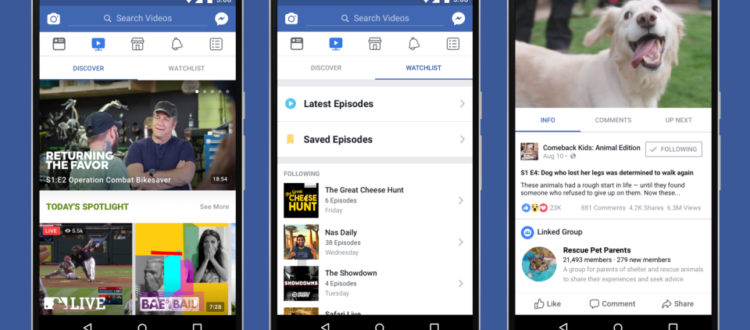Facebook Watch: Not Just a Platform, But a Community
Since 2004, Facebook has changed the way we connect with one another. Now Facebook Watch, the social network’s new video site, is attempting to change how we view and stream video. From event coverage, to reality television, episodic series, and yes, even live woodworking tutorials, Facebook Watch showcases a wide variety of high-quality original content made by professional and up-and-coming creators. Like YouTube Red and Snapchat Discover, Facebook Watch is designed with you in mind; It features a Watchlist to keep you up-to-speed on your favorite shows, it allows you to save and search episodes, and even sorts its content by popularity and length. Unlike its competitors, Watch allows viewers to share, comment on, and react to a video. Users can also participate in Facebook groups dedicated to their favorite Watch content, join conversations with friends and fans of a particular episode or series, and in some instances, may even have a say in what a series does next.
Content creators will share 55 percent of ad revenue and the platform itself should eventually operate similar to YouTube in that the content pays for itself
Facebook Watch has already partnered with A&E, Tastemade, Buzzfeed, PBS, Animal Planet, The Discovery Channel, and the MLB. However, it is Watch’s partnership with the NFL (who does not take partnerships lightly) that may have Facebook’s rivals shaking in their boots. Not only will Facebook Watch allow users to view NFL game recaps and official highlights of all 256 regular season games, the playoffs and the Super Bowl, but also it will stream NFL Turning Point and Sound FX. While this agreement won’t mean live games on Facebook Watch, it is indicative of the what is yet to come and may draw in new Watch users. The platform also recently partnered with Conde Nast. Their Facebook Watch exclusive show, Virtually Dating, is one of the most popular reality series on the platform with over 17 million views. In the five-episode series two complete strangers go on a blind date in virtual reality. Think: The Bachelorette, but set in VR outer space or a VR post-apocalyptic world with zombies. Another Facebook Watch success, Brandon Stanton’s Humans of New York: The Series, features intimate and often unpredictable conversations with strangers on the streets of New York City. The series has passed over 2.5 million views on each of its eleven episodes. Facebook has nearly 2.5 billion active users (YouTube claims 1.5 billion monthly active users). Both Virtually Dating and Humans of New York: The Series, could easily double their views in the coming year, if not months.
Can it succeed?
Facebook’s spending on video will total billions of dollars in 2018. With Americans spending more than 73 minutes a day watching digital video, up more than 7 percent from last year, Facebook Watch is a solution to a growing demand for new ways to stream video. However, Facebook pouring large sums of money into video also comes at a time when Facebook is running out of room for ads and is looking for different ways to boost ad revenue. Facebook has admittedly funded a small percentage of Facebook Watch content, paying $10,000-$35,000 for shorter form shows and up to $250,000 for longer shows, in hopes that high-quality video will spark interest in the new platform and give viewers a reason to frequently return to Facebook Watch. Content creators will share 55 percent of ad revenue and the platform itself should eventually operate similar to YouTube in that the content pays for itself and doesn’t come directly from the company’s rainy day fund.
So far, this strategy appears to be working. According to Business Insider, videos on Facebook Watch have a higher retention rate (an average of 23 seconds per video) than typical videos on Facebook’s Newsfeed (an average of 16.7 seconds per video.) Viewers seem to enjoy Facebook Watch, or at the very least they can stand to watch its content for seven more seconds. Is this really worth celebrating? 23 seconds is not a significant retention rate — the average Watch video can range from four to 20 minutes, implying the average viewing time of 23 seconds represents a retention rate between 2 percent and 10 percent. This is nothing compared to the overall consumption levels of TV and top YouTube channels. In fact, experts suggest companies should set their sights on a retention rate of about 60 percent or higher. For Facebook Watch, a platform specifically geared towards long-form content and with most videos being an average of 10-20 minutes, a 23-second retention rate indicates that viewers actually prefer long-form content. In turn, we can expect viewers to return to Facebook Watch more often and for a longer period of time resulting in significant ad revenue. As Facebook Watch grows and has more engagement, longer, scripted shows exclusively owned by Facebook and sold to Watch subscribers may become a reality.
Facebook Watch has potential, but it’s simply too early to tell if this is the real deal. In just three months it has given the industry a reason to believe that it may well be an up-and-coming player in the saturated market of content streaming. Perhaps the biggest advantage it has over companies like Netflix or Amazon is that it has a massive social media giant, Facebook, as its benefactor. The success it has achieved so far is outstanding considering it’s still fresh off of its own inception. It could very well make Netflix and YouTube a thing of the past. It is not as far-fetched as it may sound; It certainly wouldn’t be the first time Facebook rose to the top.




